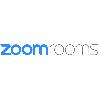Sync language support with digital signage
New or enhanced feature
General features
Sync language support with digital signage
- The interface will automatically detect and display content in the language set on the Zoom Room's operating system.
Simulive webinar
- Hosts can schedule webinars that begin with pre-recorded content and automatically transition to live interaction after the recording ends. The webinar can be configured to either end after the recording plays or continue as a live session. If no host is present when the recording ends, the webinar will automatically conclude. Hosts have the flexibility to join during the simulive portion and manually trigger the transition to live at any time. The backstage functionality is available during the simulive portion for host and panelist preparation.
Security icon for private meeting mode
- Users can identify when they are in a private mode meeting with a new visual indicator in the Zoom Rooms interface. The security shield icon will be surrounded by a house symbol when connected to an on-premise private mode meeting. Additionally, the security dialog will display more specific information about the connection, showing "You are connected to the data center controlled by xxx.zoomonprem.com" for private mode meetings.
Seamless Zoom Phone call switch between devices
- Users can now switch an ongoing Zoom Phone call between their Zoom Rooms, desktop client, mobile app, and desk phone with a single tap. When a call is active on one device, other devices will display an indicator showing that a call is in progress and can be picked up. Users can move calls to and from personal Zoom Rooms while maintaining call state, including mute status and any active recording or transcription. For Zoom Rooms, the room must be unlocked before a call can be transferred to it.
Join webinars as panelist from an external Zoom Room
- Account owners and admins can allow Zoom Rooms outside of a webinar host's account to join webinars as panelists. With this enhancement, external Zoom Rooms can join using the calendar invitation's panelist link.
Enhancements to device operation time with improved wake functionality
- Users with Logitech appliances can wake their rooms from sleep mode with a single tap.
Consolidated in-meeting notices on AppleTV
- Users joining Zoom meetings through AppleTV will experience an updated notification system that consolidates multiple in-meeting notices into a single view consistent with the user interface already implemented on desktop and Zoom Rooms clients.
Apple ID login support for Zoom Rooms
- Users can log into their Zoom Rooms using their Apple ID credentials. When accessing the login screen, users will see an option to sign in with their Apple ID alongside the traditional Zoom account login methods.
Annotation for wired HDMI screen sharing
- All participants, including remote individuals, can annotate on content being shared in a Zoom Room via wired HDMI.
In-meeting features
User interface enhancements to smart name tags
- Smart name tags has updated styling that matches the room name design. When the meeting window size is reduced below minimum requirements while using multi-stream mode, smart name tags will now display directly in the stream if there is only one tag present.
Show participants list on display
- Users can toggle a new option on the Zoom Rooms controller to show the participant list on the room's display. The participant list appears in a right-side panel, similar to the chat or transcript panel. When enabled, in-room meeting attendees can view the complete list of participants directly on the room display rather than having to reference the controller.
Real Time Meeting Stream (RTMS) disclaimer support
- Users will see a disclaimer when the Real Time Meeting Stream (RTMS) feature is enabled during a meeting in Zoom Rooms.
Higher resolution video for 4K
- Account owners and admins can enable higher resolution video for Zoom Rooms with 4K (16:9) displays through a new configuration setting in the Zoom web portal. The Support high resolution 4K displays toggle can be configured at the Account, Location, or individual Room level on the Display tab. When enabled on compatible systems, Zoom Rooms will subscribe to higher resolution video streams instead of merely upscaling 1080p content, with resolution and frame rate varying based on the number of participants and view layout selected. This feature is supported only on Zoom Rooms that meet the system requirements for high-resolution displays. Please refer to the Zoom Rooms system requirements page for details.
Enhancements to smart name tag display
- Users can see a prompt on their Zoom Rooms controller or display encouraging them to edit generic smart name tags from the participant list when they appear on the local side. A helpful tooltip is displayed when users click on the smart name tag icon, explaining what smart name tags are and how they function. When using smart name tags with Multi-stream or Intelligent Director, users can pin streams associated with specific smart name tags. Additionally, users can see some warning tips when automatic smart name tags are not available.
Enhancements to emoji reactions
- Users in Zoom Rooms will see emoji reactions displayed more prominently as overlays across the video layout rather than just within individual video tiles. The reaction display time has been reduced to provide a better experience.
Enhanced interface for closed caption speaking language in Zoom Rooms
- Users in Zoom Rooms can more easily change the closed caption speaking language when the system detects a mismatch between the current speaking language and the configured language setting. The updated user interface reduces the number of clicks needed to correct the language setting.
Admin features
Waiting room customization for Zoom Rooms
- When participants join meetings from Zoom Rooms and are placed in waiting rooms, they can now view all customized content, including videos, that meeting hosts have configured.
Room seating capacity filter
- Account owners and admins can now segment their Zoom Rooms usage data by room size through a new "Room Seating Capacity" filter in the Dashboard. The filter works alongside existing Location and Tags filters, providing predefined capacity ranges that correspond to common room types: huddle rooms (1-3), small rooms (4-7), medium rooms (8-11), large rooms (12-25), and training/event rooms (26+). This filter applies to Shared Zoom Rooms, Scheduling Display-only Rooms, and custom space types, but not desks (unless "all types" is selected).
Room reservation reporting and analytics
- Account owners and admins can access more data about room and workspace reservations through a new report. The report includes details such as scheduled meeting dates and times, actual start and end times, room names, and information about cancelled or released reservations. Admins can view when reservations were released, the reason for release (user checkout, cancellation, or auto-release), and who made the reservation.
Quick check-in for workspace desk
- Account owners and admins can configure the type of check-in method required for a workplace desk. By default, QR code scanning is required, but admins can disable this requirement through Workspace settings. When disabled, users can simply tap Check in on the desk scheduling display without needing to scan a QR code for the reservation. Admins can also choose to allow both options, if desired.
Network connectivity test tool
- Zoom Rooms administrators can use this tool to help diagnose issues. It supports running on-demand tests for meetings and advanced connectivity, similar to the feature available for the Zoom desktop client.
Control display of secondary video streams
- Users can control the visibility of in-room auto-generated video streams on displays when Smart Gallery or Intelligent Director is active. A new toggle in the View menu on the controller or touch display allows users to show or hide local auto-generated secondary video streams during the current meeting.
Configure multi-speaker view for single display rooms
- Account owners and admins can set multi-speaker view with content as a default display option for single display Zoom Rooms through the Zoom web Portal. The setting is found under Room Profile Settings in the Display tab.
Configure healthcare devices using the location hierarchy
- This feature supports healthcare use cases by enabling stethoscope recognition. Account owners and admins can configure which USB devices are identified as stethoscopes, with settings available at the account, location, and individual room levels. By default, the allowlist aligns with the existing cloud-based stethoscope device database, for compatibility with currently deployed systems. A dedicated feature toggle provides for these specialized settings to appear only when needed, to prevent unintended changes to standard Zoom Rooms.
Companion Mode UX improvement: Automatic unpairing from Zoom Rooms
- Users paired with a Zoom Room will experience automatic unpairing when they lock their device or close their laptop lid. This automatic unpairing only occurs when specific conditions are met: no active meeting is in progress, the user is not sharing content to the Zoom Room, and the user has been idle for a short period before locking or closing their device. If a meeting is in progress or content is being shared, the connection will remain intact to avoid disruption.
Automatic inactivity detection for meetings
- Account owners and admins can configure Zoom Rooms to detect when meetings are left unattended and automatically terminate them. The system uses people-counting sensors to determine room occupancy and triggers a countdown when no participants are detected for 30 consecutive minutes. A visible prompt appears on the screen, giving users one minute to acknowledge and continue the meeting if desired. Without acknowledgment, the system automatically ends the meeting, freeing up the room and system resources.
Custom AV Controller
Simplified access to Custom AV Dante audio
- Administrators can enable Custom AV Dante directly through the Zoom web settings for each Zoom Room, rather than requiring account-wide enablement from Zoom support. This setting can be found in the new Custom AV section of the Zoom Rooms web settings. Custom AV Dante provides up to 32 output channels controlled through the Custom AV Zoom Rooms Controller. Note : Accounts that had this feature enabled by Zoom support will have this setting enabled by default.
Persistent Dante content assignments
- Admins can now configure and assign content to Custom AV Dante channels outside of meetings. These assignments persist between meetings, system restarts, and controller pairing changes. This functionality allows system integrators to configure permanent Dante channels for participant audio, content share, mixed audio, or other audio types.
Custom AV Dante audio output for language interpretation channels
- Users can now output isolated language interpretation audio from a Zoom Room through Custom AV Dante audio channels. Within the Custom AV Zoom Rooms Controller, an admin can assign specific interpretation languages to dedicated Dante audio channels, with support for multiple simultaneous language channels.
Custom AV Dante audio gallery mix output
- Administrators can configure a new Dante audio output type called "Gallery Mix" in the Custom AV Zoom Rooms Controller or through the ZRC SDK. This audio type provides a combined mix of all participants that are currently placed on a specific gallery page. When participants move between galleries, their audio automatically moves to the corresponding mix.
Configurable size for Custom AV overlays
- Integrators and admins using the Custom AV Zoom Rooms Controller or developers using the ZRC SDK can specify a custom size for the various overlay elements displayed on NDI and Hardware outputs in Zoom Rooms. This includes the name tag, mute icon, reactions, feedback, and poll result overlay.
Zoom for Home features
Join Zoom meetings on Apple TV without Continuity Camera
- Users will have the option to join meetings on Apple TV without having to connect a Continuity Camera.
Resolved issues
- Minor bug fixes
- Security enhancements


